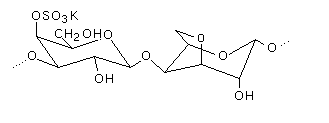Primary structure
The basic structure of carrageenan is a linear polysaccharide made up of a repeating dissacharide sequence of α-D-galactopyranose linked 1,3 called the A residue and β-D-galactopyranose residues linked through positions 1,4 (B residues). Carrageenans are distinguished from agars in that the B units in carrageenan are in the D form whereas they are in the L form in agar’s.

The original classification of carrageenan was determined by the fractionation of the polysaccharide with potassium chloride.The fraction that was soluble in 0.25M KCl was called lambda carrageenan and the fraction that was insoluble was called kappa carrageenan. Rees and his co-workers later altered this so that kappa and lambda carrageenan referred to idealised specific disaccharides.
The regular backbone structure of The basic structure of carrageenan is disrupted by a more or less ordered distribution of sulphate hemi ester groups. Carrageenan can also contain some methoxy and pyruvate groups.

Gelling in carrageenan is caused by helix formation and this can only occur in repeat structures where the B residue is in a 1-C-4 conformation. Lambda carrageenan has both its sugar residues in a 4-C-1 conformation and does not form gels. All the gelling types of carrageenan which include κ and ι all contain a 3,6 anhydro bridge on the B unit which forces the sugar to flip from a 4-C-1 conformation to a 1-C-4 conformation and can then form cross-link networks and gels.

Some types of seaweed species contains relatively pure carrageenan fractions Kappaphycus alvarezii & K. striatum contain largely κ carrageenan and μ carrageenan which may be converted to kappa carrageenan by alkali treatment. Eucheuma denticulatum contains a similarly high level of ι carrageenan with some ν carrageenan precursor. Furcellaria contains a strong gelling type carrageenan, known as furcellaran, which is very much like kappa carrageenan. Other seaweed types, such as Chondrus crispus and Gigartina types contain not only a mix of κ and λ type carrageenans but also a type of carrageenan polymer that is essentially a block copolymer of different carrageenan types. This gives the carrageenan made from Gigartina or Chondrus weed species quite different properties from those made from the Kappaphycus & Eucheuma type species from South east Asia. you will also see later that the differences in structure also enable quite different processing conditions to be utilised for the different weed types.
Further information on carrageenan sources, production, synergy and protein interaction can be accessed using the arrows in the Further Reading box below.
Further Reading
Read more on Carrageenan
